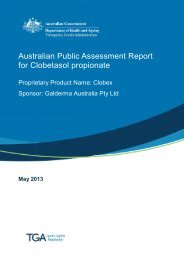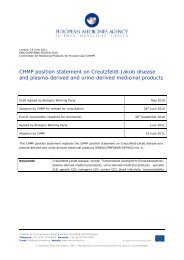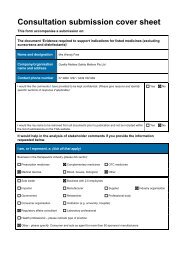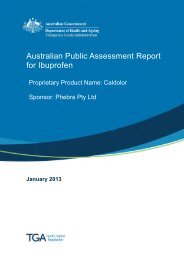AusPAR: Ivabradine - Therapeutic Goods Administration
AusPAR: Ivabradine - Therapeutic Goods Administration
AusPAR: Ivabradine - Therapeutic Goods Administration
You also want an ePaper? Increase the reach of your titles
YUMPU automatically turns print PDFs into web optimized ePapers that Google loves.
Other studies<br />
Not applicable.<br />
Electrocardiograph<br />
Pivotal studies<br />
<strong>AusPAR</strong> Coralan <strong>Ivabradine</strong> Servier Laboratories (Australia) Pty Ltd PM-2010-03269-3-3<br />
Final 31 October 2012<br />
<strong>Therapeutic</strong> <strong>Goods</strong> <strong>Administration</strong><br />
Electrocardiograms were taken to detect the lowest heart rate on treatment present in<br />
patients on the Safety Set. An on-treatment recording of HR < 40 bpm was reported in<br />
0.3% (10/3178) of patients in the ivabradine group versus 0.1% (3/ 3209) in the placebo<br />
group. An on-treatment recording of HR < 50 bpm was reported in 21.3% (676/ 3178) of<br />
patients in the ivabradine group versus 2.2% (70/ 3209) in the placebo group.<br />
Overall, the proportion of patients with asymptomatic bradycardia that led to study drug<br />
discontinuation was 0.9% and 0.2% in the ivabradine and placebo groups, respectively,<br />
and that for symptomatic bradycardia was 0.6% and 0.2%, respectively. Asymptomatic<br />
bradycardia that was considered treatment-related SAEs occurred in 0.1% and 0% in the<br />
ivabradine and placebo groups, respectively. Symptomatic bradycardia that was<br />
considered treatment-related SAEs occurred in 0.4% and < 0.1% in the ivabradine and<br />
placebo groups, respectively.<br />
Other studies<br />
Not applicable.<br />
Vital signs<br />
Pivotal studies<br />
Sitting systolic blood pressure (SBP) and diastolic blood pressure (DBP) were measured at<br />
each scheduled visit during the study. There was a small increase in mean sitting SBP<br />
between baseline and last value on treatment in both treatment groups (mean change ±<br />
SD of + 4.1 ± 16.0 mmHg in the ivabradine group and +2.0 ± 16.2 mmHg in the placebo<br />
group).<br />
There was minimal change in mean sitting DBP between baseline and last value on<br />
treatment in both treatment groups (mean change ± SD of +0.4 ± 10.2 mmHg in the<br />
ivabradine group and +0.7 ± 10.3 mmHg in the placebo group).<br />
Other studies<br />
Not applicable.<br />
Postmarketing experience<br />
No postmarketing data was provided. The proposed PI contains data regarding<br />
postmarketing experience, which is unamended from the currently approved PI and states<br />
that “The following adverse reactions (frequency unknown) have been reported in<br />
postmarketing use with ivabradine; rash, erythema, pruritis, hypotension, malaise,<br />
syncope (possibly linked to bradycardia).”<br />
Other safety issues<br />
Safety in special populations<br />
In the subgroup of patients aged ≥ 75 years (N = 720, n=367 in ivabradine group, n=353 in<br />
the placebo group), the incidence of TEAEs was comparable between the ivabradine group<br />
and the placebo group (78.8%, 50.3%PY versus 77.6%, 48.0%PY, respectively) (Table 16).<br />
The most frequently reported TEAEs by SOC were Cardiac disorders (50.1%, 32.0%PY<br />
versus 47.3%, 29.2%PY, respectively), Infections and infestations (26.2%, 16.7%PY versus<br />
26.1%, 16.1%PY, respectively) and Vascular disorders (13.9%, 8.9%PY versus 14.2%,<br />
Page 44 of 101
















